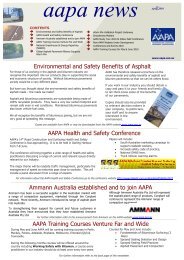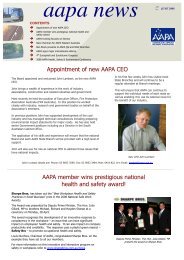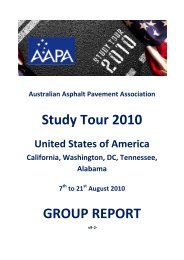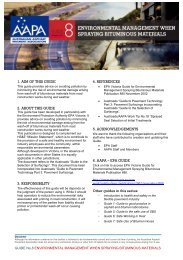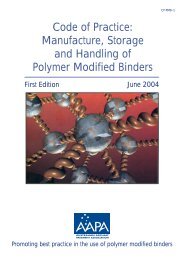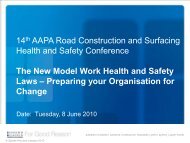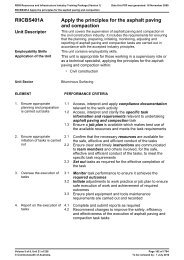Asphalt Review - Volume 29 Number 1 (February / March 2010)
Asphalt Review - Volume 29 Number 1 (February / March 2010)
Asphalt Review - Volume 29 Number 1 (February / March 2010)
- No tags were found...
Create successful ePaper yourself
Turn your PDF publications into a flip-book with our unique Google optimized e-Paper software.
ASPHALT REVIEW<strong>Asphalt</strong> paving had to be finished at 5.30am to allow sufficient cooling of the freshpavement in order to make sure that it wasfirm enough when the first plane toucheddown.New profile produced fullyautomatically<strong>Asphalt</strong> work kicked off with the paving ofbase course. As the reconstructed runwaywas also to be given a new profile, thelayer thickness varied. Measuring just 8cmtowards the centre, the thickness in thelateral areas of the runway was up to 14cm.The runway’s precise geometry was storedas a digital specification in the 3D controlsystem. Based on this data, the parametersfor the machines equipped with NavitronicPlus® were set fully automatically. Whenit came to paving 8cm binder course, theteam wanted to be on the safe side, too,for adherence to the specified grade. Sothey opted to also rely on their VÖGELE“autopilot”. Already at the stage of thesetwo lower courses, which had to level outa number of irregularities in the sub-base,the specified profile was built with highprecision.Perfect match for NAVITRONICPlus® when paving wearingcourseWhen paving wearing course of just 4cm,the focus was on evenness in a longitudinaldirection rather than the absolute grade;therefore, grade control by NAVITRONICPlus® was switched off. NAVITRONICPlus® continued controlling the screed’sposition and the paver’s direction ofmotion, but grade control for the twoSUPER 1800-2 pavers was carried out byVÖGELE Big MultiPlex Skis. These multicellsonic sensor systems are capable ofprecisely levelling out even the smallestirregularities.Three VÖGELE pavers workingside by sideThe 45m wide runway was paved in sixstrips of 7.5m each. Three of the strips werepaved “hot to hot”, with the first and thirdstrip laid by two VÖGELE SUPER 1800-2pavers. For the central strip, a SUPER2100-2 was used. All three machines camewith AB 600-2 High Compaction Screedsin TP1 version. NAVITRONIC Plus®undertook full control of the two SUPER1800-2 pavers for the outer strips. SUPER2100-2, which followed in between, didnot need 3D control as it used the freshlypaved adjacent strips as a reference andscanned them with two multi-cell sonicsensors.High demands on logisticsThe smooth progression of pavingwas equally important as the righttechnology for the successful executionof the project. The complex job sitelogistics had been elaborated downto the last detail; from the projectmanager to machine operators, theteam worked hand in hand. This wasthe only way to ensure that up to 3,500tonnes of asphalt could be suppliedand paved in a single night shift. Mixfor some 30 feed cycles was stored ina specially prepared hangar on theairport grounds. This mix served asbuffer in case supply from the fiveasphalt plants stagnated.WIRTGEN milling machineremoves asphalt pavementBefore the VÖGELE machines beganpaving, a large WIRTGEN W 2200milling machine arrived each night.A few minutes after the job site hadbeen illuminated and secured, itmilled off the transition area betweenthe old runway and the freshly pavedsection. This was necessary as the newpavement was laid directly onto the oldone. In order to ensure that planes cansafely take off and land during the day,the level of the new pavement had tobe adapted to the old one at the end ofeach night shift. After milling, the teamcleaned the section to be reconstructednext and sprayed tack coat. Then theSUPER pavers took over.Renewal of drainage systemand air beaconWhile reconstruction of the runwaywas under way, the foundations ofthe boundary lights and the drainageslits were replaced. The overall projectalso included rehabilitation of allconnecting taxiways and aprons,pavement markings and the layingof cable ducts for subsurface andcentreline lights. During construction,the lighting systems had to be activatedand markings applied every morningbefore handing the runway back to airtraffic.For more details go to www.prewe.com/voegele19.zip46 ROADS FEBRUARY <strong>2010</strong>/MARCH <strong>2010</strong>



